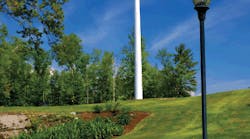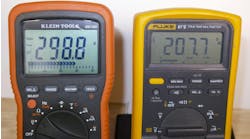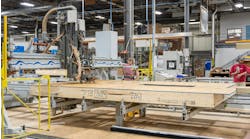Enormous wind farms, with individual machines rated in excess of 1MW, have dominated media coverage over the last several years, just as these huge turbines dominate the high plains and ridges across the country. But recently there has been a resurgence of interest in small wind turbines as well. While nameplate ratings are much less, advantages of these units include the fact that expensive and potentially controversial transmission lines are not an issue, making this option realistic for homes and small commercial facilities. In addition, smaller units (typically recognized in the industry as being rated 100kW or less) can be set up as stand-alone, battery-charging machines for off-grid usage or grid-tied electric utility interactive systems (Photo 1).
For small turbine installations, the power is used fairly close to where it is generated, and power lines are contained within the end-user’s property lines. Installation costs can be mitigated by a 30% tax credit, which was enacted on Oct. 3, 2008. The Emergency Economic Stabilization Act of 2008, H.R. 1424, includes a U.S. investment tax credit available for home, farm, and business wind power installations of less than 100kW capacity. This credit will run through Dec. 31, 2016, unless it is extended. For now, the credit may roll over into subsequent years or be used to liquidate a tax liability.
To qualify for the credit, it is necessary to document the cost of the system, when it was placed in service, and whether it qualifies in terms of system size and premises type. Homeowners should use IRS Form 5695, Residential Energy Credits. Businesses should use IRS Form 3468, Investment Credit. There may also be other state and local financial incentives available to further reduce the installed costs of such systems. Additionally, small wind turbine installations that feed back into the utility electric system are typically eligible to receive credit at the retail electricity price level.
As we have seen, the small wind turbine system plays an important role in the overall renewable energy spectrum. Wind is an abundant resource, and the know-how to extract electrical power from it is certainly within the reach of interested and savvy electrical professionals.
Design basics. In its simplest form, a wind generator consists of a two-blade rotor coupled via a horizontal shaft to a DC generator. A low startup torque load operates most efficiently with two blades, although a third blade is frequently added to minimize instability. A high startup torque load requires a multi-blade rotor, seen throughout the Midwest in water pumping operations for livestock use where there is no electrical service (Photo 2).
The output of the simplest machines will be DC that is intermittent and of varying voltage. If used to charge batteries, the voltage will be regulated by the load due to the voltage-regulating nature of the batteries and the relatively high impedance of the generator. As wind speed and rotor rpm increase, a constant voltage is maintained, but the amount of current and rate of charge increase.
This simple system is easy to troubleshoot and maintain. A reverse biased diode is placed in series with the batteries so they will not discharge through the turbine, causing it to spin when there is no wind and needlessly discharge the batteries. The diode should be chosen to have sufficient current-carrying capability when forward biased; otherwise, it will overheat and have a short life.
A normally off push-button switch is usually placed in parallel with the diode, allowing you to shunt or disable the diode and operate the turbine as a motor for maintenance and troubleshooting purposes. This switch can be marked “motor” and should have lockout capability to eliminate the chance of worker injury during maintenance operations. A pilot light is also useful to indicate turbine status.
The design of the turbine must provide for destructively high wind conditions. Some models are designed so that they tip down when the wind hits a predetermined speed; others turn sideways. Some units provide a spoiler that activates upon centrifugal force. Other high-wind disabling means include disc or drum brakes, variable blade pitch, and electronic damping.
Contemporary small turbines generally feature a tail, which causes the machine to yaw into the wind for maximum energy capture. Large wind farm machines embody a wind-direction sensor and servomotor coupled to a large ring gear. This arrangement works well for large machines, but the cost is prohibitive for small-scale power generation. Due to the low current, it’s feasible to have a slip ring/brushes arrangement to transmit power down the tower even as the turbine rotates, as opposed to more complex equipment needed to control cable twisting for more powerful machines.
A variant of the blade-type turbine is the vertical axis wind turbine (Photo 3), one type of which is called the Darrieus machine. These units have several advantages over a blade-type unit. For example, no yaw motion is required, because they capture energy irrespective of wind direction. Another advantage is that the generator is on the ground, where it can be better protected from the elements and easier accessed for maintenance and repair.
Such a machine can be built by cutting steel drums in half longitudinally and welding them to the vertical shaft. The principle of operation is that the concave surface is affected more by the wind than the convex side, causing the rotor to turn regardless of wind direction. However, the force on the convex side must be subtracted from the force on the concave side, meaning that efficiency will always be less than that of a horizontal shaft machine. For this reason, despite some promising trials, vertical shaft machines have failed to make any substantial market penetration.
Utility-Connected Systems
So far, we have discussed the features of an off-grid stand-alone type system, which charges a battery bank to power the premises. These same wind turbines can also be configured to feed power back into the local electric utility system. This type of setup, called a utility interactive system, offers significant advantages to the owner, provided the unit is located close to the utility power lines. One benefit of the utility-interactive system is that no battery bank is required, which saves significant up-front costs as well as recurring costs for maintaining and replacing batteries.
Typically, alternating current from within the wind turbine is rectified to DC, which, in turn, is processed by an inverter to create a usable sine wave AC output. Voltage and frequency output have to match utility parameters. Moreover, the inverter output (AC) must be phase locked to the utility power system. Local load variations must not disrupt this matching process. In addition, the wind power system must be designed so it can be disconnected from the utility system in the event of an outage to ensure utility maintenance personnel are not exposed to dangerous and unexpected electrical energy. The electronics that accomplish this task are somewhat complex. However, from the point of view of the wind system designer or installer, the equipment is supplied by the manufacturer, and external connections are straightforward.
NEC Guidelines
The 2011 NEC provides requirements for the safe installation of small turbines in a new Art. 694 [Small Wind Electric Systems]. This Article is applicable to stand-alone and utility-connected systems rated 100kW or less. The requirements are similar to those provided in Art. 690 [Solar Photovoltaic Systems] and Art. 692 [Fuel Cell Systems]. There are 14 definitions listed in Art. 694, four of the most important of which are highlighted in the SIDEBAR: Key NEC Terms below.
It is clearly noted that systems covered by this Article are to be installed only by qualified persons, previously defined as one who has skills and knowledge related to the construction and operation of the electrical equipment and installations — and has received safety training to recognize and avoid the hazards involved. These hazards may be substantial when you consider that it may be necessary to climb fairly high towers to service the electromechanical equipment. Moreover, battery banks must be installed correctly to prevent hazards from hydrogen gas (emitted during the charging cycle) from exploding in the presence of an electrical arc. (There are also corrosion issues that must be considered.) In addition, totally reliable lockout means are necessary to prevent unwanted rotation during maintenance.
Code requirements involve circuit sizing, overcurrent protection, disconnecting means, wiring methods, and grounding. These are located in the first three NEC chapters, which apply generally to electrical installations. There are a few specialized small wind electric systems mandates found in Art. 694. For example, Sec. 694.22 states that where all terminals of the disconnecting means are capable of being energized in the open position, a warning sign to that effect is to be posted on or adjacent to the disconnecting means. It is mandated that in readily accessible locations, turbine output circuits that operate at more than 30V are to be installed in raceways. For work inside the building, EMT is widely used.
Exposed non-current-carrying metal parts of towers, turbine nacelles (enclosures housing the alternator and other parts of a wind turbine), other equipment, and conductor enclosures are to be connected to an equipment grounding conductor. Guy wires used to support turbine towers are not required to be separately grounded unless required by local lightning codes (Photo 4). It is further noted in the Code that a wind turbine tower is to be connected to one or more auxiliary grounding electrodes to limit voltages imposed by lightning. An effective method for achieving this is to use concrete encased grounding electrodes within the tower foundation. Provisions should be in place to address this in the early stages of construction.
All interactive system points of connection with other sources are to be marked at an accessible location at the disconnecting means and with the rated AC output current and the nominal operating AC voltage. Buildings or structures with both utility service and small wind electric systems equipment within them must have a permanent plaque or directory providing the location of the service disconnecting means and the small wind electric system disconnecting means. Only inverters listed and identified as interactive are permitted in an interactive system.
Don’t Blow it
In times like these of economic uncertainty, electrical contractors seeking additional revenue streams should explore the option of installing small wind power systems for their clients. Check out the tax abatements, loan guarantees, and other incentives available in your state that would augment the 30% federal tax credit. You might also want to install a small wind turbine at your own place of business as a start. This installation will not only allow you to gain experience in this area, but also attract interested individuals to firm, which one day might actually become your customers.
Herres is a licensed master electrician in Stewartstown, N.H. He can be reached at: [email protected].
Sidebar: Key NEC Terms
The 2011 NEC provides requirements for the safe installation of small turbines in a new Art. 694, which includes 14 definitions, a few of which are highlighted below.
Charge controller. Equipment that controls DC voltage, DC current, or both — and is used to charge a battery or other energy storage device.
Diversion charge controller. Equipment that regulates the charging process of a battery or other energy storage device by diverting power from energy storage to DC or AC loads or to an interconnected utility service.
Diversion load. A load connected to a diversion charge controller or diversion load controller, also known as a dump load.
Diversion load controller. Equipment that regulates the output of a wind generator by diverting power from the generator to DC or AC loads or to an interconnected utility service.



